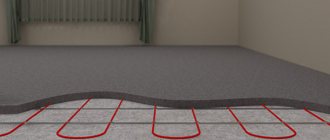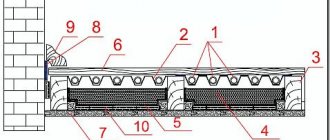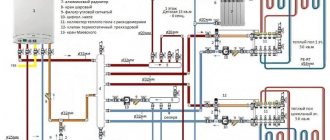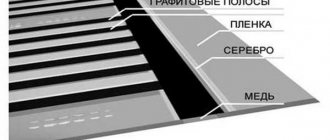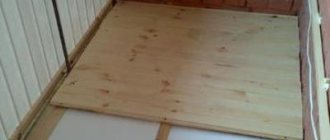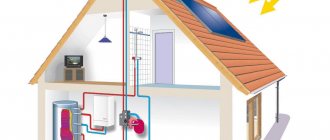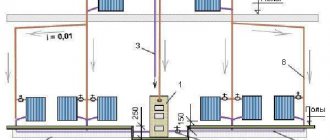Connection
If the choice fell on heating using underfloor heating, then you will have to make the correct connection to the radiators. A significant investment will be required, which will be aimed at piping the solid fuel boiler. In this case, you simply cannot do without a buffer capacity. The main reason is that it is quite difficult to heat a water floor to the required temperature using firewood, because we are talking about maintaining the temperature inside the system. Such a system requires timely heat release, otherwise the existing water jacket may overheat and even boil.
It is very problematic to heat the coolant to 40°C using solid fuel, since its operating temperature is about 55°C. If the temperature drops, this will lead to the formation of condensation, which will eventually create holes in the metal walls. Even if you use a cast iron boiler, this will not help to avoid possible corrosion. In the presence of condensation, a characteristic deposit begins to form, which does not allow the fuel to burn efficiently. To maintain the efficiency of the entire system, it is necessary to install a heat accumulator.
Connecting the "warm floor" system
Before connecting the heated floor to the system, it is worth preparing the distribution unit. To ensure that the geometry of the room is not disrupted when it appears, build it into the wall. So, you need to make a niche in the wall in which to place a special box equipped with a door. Place the outputs (three) and two combs in it. The supply pipe will be connected to it on the side, and at the exit there will be three channels for connecting pipes. For outflow, you need to place the comb lower. Place taps in front of the outlet pipes.
The temperature regime in the house can be adjusted automatically: special valves will help with this, with the help of which you can set the system to the required temperature.
Types of boilers
All boilers are divided into two types:
- Double-circuit products.
- Single circuit products.
Double-circuit devices are capable of performing several tasks: water heating and heating. The water is heated due to the fact that such a boiler is equipped with a storage boiler. And some models, instead of a boiler, are equipped with a supply heat exchanger, which also provides water heating.
Single-circuit devices. In a heating system, such boilers only heat the coolant, that is, they can only be used to heat the house. But in order for them to provide water heating, then you need to additionally purchase: boilers, mixing units and many other devices. Only in this case will it be possible to connect a warm floor.
Based on the type of installation, boilers are divided into two categories:
- Suspended-type equipment, the power of which reaches up to thirty-five kilowatts.
- Floor-standing boilers have a power of up to one hundred and twenty kilowatts.
Among these two types, suspended models are the most popular because they require significantly less cost and are easy to install. Wall-mounted boilers are equipped with a circulation pump and other devices that are necessary for a boiler room. In order to put such equipment into operation, all that needs to be done is to attach pipes through which hot water will flow and connect the heating pipeline. Models that are equipped with a storage boiler are ready-made small boiler rooms from which water for the batteries will be heated.
If you are interested in which boiler is better to choose and how to connect a heated floor, you first need to find out what types of such equipment exist. To install a warm water floor system in your house, which will be heated by a boiler, you can consider the following types of automatic heating devices:
Electric water heating equipment.
- Single-circuit gas boiler.
- Double-circuit gas equipment.
To heat a water floor, you can choose any of these types, but there is an important condition here - the operation of such equipment must be automated. Most often, electric or gas 2-circuit equipment is chosen
However, if we take into account that the price of energy resources is constantly increasing, then installing a gas boiler is much more profitable from an economic point of view. However, in order to make a water heated floor connected to such equipment, you need to provide a separate room in advance, and also equip a good ventilation system.
In addition, a collector can be installed in a separate boiler room. A gas 2-circuit unit will be able to warm up the air well, plus it will provide the house with hot water. However, its installation for a warm water floor must be carried out in compliance with a number of important rules. Such work should be carried out by gas service workers, but independent installation of gas equipment will be considered illegitimate and will not meet accepted standards.
Installing an electric boiler, unlike a gas one, is not particularly difficult and can be done independently. Such heating equipment is environmentally friendly, which cannot be said about other types of boilers; moreover, the connection diagram for a heated floor to such a boiler does not require special knowledge. However, this unit has one big disadvantage - the high price of electricity, which is constantly growing. Electric heating devices can be installed both in private houses and in city apartments.
The diesel unit for the “warm floor” system is most suitable for installation in cottages. Installing such equipment is not very difficult; their installation scheme is quite simple. Diesel models are easy to use, however, in order to maintain their smooth functioning, they need to be constantly monitored.
Solid fuel heating units are also suitable for country houses. For their work, coal briquettes are used. As for the power of solid fuel boilers, it, like the efficiency (efficiency factor), is very high. In houses with heating radiators, a solid fuel unit is considered the best option.
It doesn’t matter which of these boilers you choose, before purchasing it you need to calculate its power, you also need to correctly find the place where the heated floor will be connected, and purchase additional devices, such as a storage boiler, etc.
Top tie
After working with the pipes, move on to the top screed. Place the beacons on the cement mortar and allow time to dry (twenty-four hours).
Recommendations from experts
- After the work has been done, it is advisable not to turn on the boiler at full power.
- To optimize the temperature regime in a house with a heated floor system, you need to choose the right floor covering.
- Do not use carpeting in the bedroom or nursery.
Exploitation
- The project needs to be launched in the autumn.
- It is not difficult to install a heated floor from a boiler in a house with your own hands: do not deviate from the process technology.
Warm floors from a gas boiler are the key to the health and joy of your loved ones!
How to choose a solid fuel boiler for heated floors
When heading to the store to buy a solid fuel boiler, most people have no idea what exactly to look for. They rely on salespeople who often act in their own interests
Let's consider the issue of choice more carefully. The main criteria for a solid fuel boiler are the following parameters:
- Power.
- Power regulator.
- Energy dependence.
- Method of heating water.
Let's look at each of them in more detail.
When calculating the power, they take into account how well the room is insulated, as well as its area. On each boiler, the manufacturer indicates the volume that can be heated by the boiler in the absence of heat loss
Otherwise, buy a solid fuel boiler with a power 24% more than needed.
Manufacturers produce boilers with and without power regulator. It can operate automatically or manually. The first option is more economical.
The use of energy dependence in the design of a solid fuel boiler increases its performance, but makes the boiler dependent on the electrical supply and reduces the level of autonomy.
The method of heating the water plays an important role..
When a device is required not only for heating the house, but also for supplying hot water, then a double-circuit boiler is chosen, since it heats the water in flow mode. If a storage device is needed, a buffer capacity is installed.
Safety requirements
Safety requirements for operating gas equipment are almost the same for all types of boilers.
Basic provisions
:
- a separate room is required to accommodate the gas boiler;
- The boiler room must be equipped with a gas analyzer so that in case of gas accumulation (for example, spontaneous extinguishing of the burner) it can be notified in time;
- there should be no foreign objects in the boiler room, especially flammable ones - paint, solvent, chemicals, etc.;
- the boiler must be free for air flow, it is prohibited to lean or lean anything against it;
- If you detect a smell of gas, immediately turn off the supply, notify the gas service and ventilate the room. When using propane-butane, ventilation may be useless, since it is heavier than air and accumulates at the bottom;
- Do-it-yourself repair of boiler safety sensors is prohibited.
The requirements are simple, but they must be strictly observed to avoid dangerous consequences.
Gas heating of a turnkey house
The use of gas makes it possible to implement several types of heating systems (HC) for a private home:
Air. This system was widely used in the USA at the end of the 20th century. In Russia it can be observed in shopping centers, production workshops, large warehouses, etc. The heat generator is a heater. The operating principle is based on heating the supply air with a heater with a built-in gas burner. A clear advantage over a water system is that there is no need to lay water pipelines, which may be prone to freezing. If liquefied gas is used, the optimal solution would be to install an additional air-to-air heat pump, which will allow the house to be heated at significantly lower costs until the outside temperature drops below -10 °C. This technological solution will solve the problem of both heating and air conditioning. It is also important to note that the air heating system also allows you to regulate air humidity, the degree of purification and ionization. If priority is given to water heated floors, then it is possible to install a water heater connected to a gas boiler. When using only a gas heater, the disadvantage is the inability to prepare hot water, but this can be solved by installing a gas instantaneous water heater. At your request, the engineering team of our company will provide a commercial proposal for the creation of this turnkey system, based on the design of your home.
Electrically independent. It is possible to implement completely electrically independent heating by installing several gas convectors instead of conventional radiators. The design feature is that gas combustion takes place in a closed combustion chamber of each of them, and smoke removal and air flow are realized by coaxial chimneys, which are discharged horizontally through the wall and end with decorative grilles. The gas pipeline is laid along the facade of the house and is supplied to each of them. The convectors are absolutely safe and are equipped with automatic shut-off of the gas supply when extinguished. Temperature control is mechanical, on each convector separately. 15 years of practical experience of our company’s engineering team confirms the fact that in terms of reliability, durability and safety, this system is superior to any analogues. Simplicity and reliability make it easy and inexpensive to maintain and repair (which happens extremely rarely). As for the costs of creating such a system, they do not significantly exceed the costs of a water system. It is worth emphasizing that some models of convectors are designed in the form of fireplaces and are perfect for any interior of a country house. In addition to numerous advantages, it is also worth mentioning the disadvantage - there is no possibility of creating a hot water supply, but this task is also achieved by installing an additional instantaneous gas water heater. Soon we will be able to calculate the cost in an online estimate, but at the moment we are ready to prepare an individual commercial offer based on your request.
Water – classic and most popular. It is called water because the coolant is water, which is heated in a heat generator (boiler) and gives off heat to heat emitters. Classic heat emitters are radiators (batteries), but there is also the possibility of installing air heaters in the supply ventilation system, creating a snow melting system, connecting a chiller and fan coils to realize the task of air conditioning, and an indirect heating boiler or instantaneous high-speed water heater - hot water supply. A properly designed system will allow you to easily solve the problem of heating water in the pool and even install water infrared heat emitters around it. This system makes it possible to heat several separate buildings at once from one boiler. It is also worth mentioning the possibility of providing thermal curtains. The main advantages of a water system with a gas boiler are: a large selection of materials used; speed of installation; the possibility of creating both at the stage of building a house and during interior finishing work; connection of a remote temperature control system; implementation of underfloor heating.
DIY installation and connection of the boiler
A long-burning solid fuel boiler is sometimes installed with your own hands; for this you should follow a certain procedure:
- Perform preparations. Drawings and diagrams are checked. They choose the future premises, pour a concrete platform on which the equipment is mounted.
- Establish communications.
- Perform tying. The most labor-intensive stage of work. All communications are being connected. If the model is double-circuit, the return flow for water heating is connected. Next, a connection is made for additional equipment, for example, a buffer tank. If necessary, a draft regulator is installed.
- Install a brick chimney or other combustion exhaust element.
- Check the smoke exhauster and chimney.
- Perform final preparatory work.
- The system is started.
That’s all, the long-burning solid fuel boiler “Palych” (or any other) has been installed with your own hands and is ready for use. The first launch is performed outdoors. Pressure tests are also carried out before it. Turn on the water supply, having previously opened all plugs and valves, raise the system pressure to 1.3 Atm. Check the boiler for leaks
Particular attention is paid to joints and welding connections
Connecting a gas boiler to a heated floor
We looked at how to make a warm floor in a wooden house with gas heating, now we need to talk about connecting the system to the boiler itself.
Collector connection diagram
Manifold diagram for connecting a heated floor.
To organize a warm water floor in a house with wooden floors from a gas boiler with your own hands, you can use a manifold connection diagram. In this case, it is necessary to connect the pipes of the heating system to the boiler through a manifold. The connection occurs after laying the floor and installing the manifold cabinet.
Think in advance about a place for the manifold cabinet, where it will be convenient to install the supply and return pipes. They are connected to the side outlets of the collector, on which shut-off valves were previously installed.
Advice. It is better to purchase a manifold kit that includes shut-off valves at all outlets for warm water pipelines. Thanks to this, if necessary, it will be possible to turn off only one circuit, while the rest of the system continues to operate.
Valves, pipes and manifolds are connected with compression fittings. Connecting water pipes to the collector can be done with special connectors consisting of a clamping ring, a nut and a support sleeve. When connecting different diameters, adapters are used.
Connection of manifolds with shut-off valves.
The simplest design consists of conventional manifolds with shut-off valves. The return and supply are connected to pipes and taps, and carrier pipes and manifolds are also connected. This scheme is easy and quick to install, but is the least convenient.
In a more complex system, in addition to shut-off valves, there is a three-way mixer, a drain valve, an air vent and a circular pump. Shut-off valves can be replaced by control valves equipped with a thermal cylinder with paraffin, the purpose of which is to determine the throughput of the valve.
The mixing pump is mounted between the manifold and the supply pipe. Its third outlet goes to the return pipe before the return pipe. Thanks to this, the equipment takes water at a low temperature and transfers it to the supply.
Connection via mixing valve
If the flow is good enough, a three-way valve can be used instead of a pump. Its installation is carried out in the same way as the pumping and mixing unit at the return outlet.
Below is a diagram showing what this system looks like.
Three-way mixing valve.
Connection using a circular pump
If the pressure is not good enough and a mixer is not needed, use a circulation pump. It is mounted on the return, since when installed on the supply, it will take additional water from the heating system, and less heat will remain in the radiators.
Circular pump diagram.
From this material you learned how to make a warm water floor on a wooden base from a gas boiler and you will be able to make all the necessary connections yourself. However, you need to remember such an important factor as safety precautions. Do not under any circumstances neglect the requirements for this equipment and strictly follow the operating instructions. The equipment must be equipped with a high-quality automation system, which will shut down in the event of a disruption in technological processes. Do not neglect the annual inspection and maintenance of your gas boiler by specialized services.
Choice
First of all, you should choose a water heater for underfloor heating of suitable power.
Calculating the power of a boiler is a difficult task; the easiest way is to proceed from the average value - 1 kW of power per 10 sq. m. area. It is necessary to pay attention to the possibility of adjusting the boiler operating mode. It is best if there is the possibility of smooth adjustment. It is also necessary to decide on the required number of circuits, type of installation and other characteristics of the boiler that will best meet the requirements of the existing room
It is also necessary to decide on the required number of circuits, type of installation and other characteristics of the boiler, which will best meet the requirements of the existing premises.
How to make a heat accumulator with your own hands
A do-it-yourself heat accumulator for a solid fuel boiler is an energy-efficient and simple design, representing a container in the middle of which there is a coolant that receives and stores energy. After the boiler has completed its operating cycle, the room is heated by absorbing the previously collected energy. Thanks to this, the heat accumulator significantly increases its efficiency and significantly saves resources.
Heating from a solid fuel boiler (installed by yourself) with a heat accumulator consists of many spiral tubes that are located around the entire perimeter of the container. This arrangement is explained by the fastest possible use of heat. Each of the spiral circuits located in the container is responsible for one action. For example, the first receives the generated thermal energy, the second heats the area of the room (building), the third heats water for domestic purposes.
Advantages of using a heat accumulator:
- Accumulation and concentration of thermal energy.
- Possibility of combining two or more heat sources.
- Increase in productivity.
- Availability of water heating.
- Temperature adjustment.
A solid fuel boiler with a water circuit, installed by yourself, allows you to save money when it is equipped with a heat accumulator.
To make your own heat accumulator for a boiler, you will need a large capacity. It is almost impossible to make it yourself. The ideal option is a stainless steel tank or any container with a lid. The thickness of the steel used is 4-9 mm. The preferred shape is a cylinder or sphere, in extreme cases a cube.
A suitable option is a barrel. For a cottage or country villa, the minimum barrel volume for a solid fuel boiler starts from 1 ton. On large containers, before using them, stiffening ribs are welded on, which will significantly strengthen them.
Having received the necessary container, think about its location, since in the future it will be much heavier. Next, diagrams and drawings will be needed.
Let's look at the step-by-step production of a heat accumulator for a solid fuel boiler. The procedure for its manufacture:
- A flange is welded to the size of the cover. In the future it will be used for bolted connections. To seal the lid, stiffeners are installed.
- The surface inside is treated with orthophosphoric acid (solution), primed 4 to 6 times and covered with two to three layers of high-temperature paint.
- Welding work is being carried out. Coils are welded inside the barrel.
- If possible, powder coating is done along with the coil. It allows you to obtain a high-quality coating, which increases anti-corrosion properties.
- The main tank and coil are checked for leaks.
- The outside of the barrel is being sanded and painted. The preferred paint is silver.
- Insulated with a layer of aluminum foil and a thick ball of min. cotton wool.
Safety requirements:
Considering that the heat accumulator for a solid fuel boiler is constantly heating up, fire safety rules must be observed
Anything that catches fire quickly and easily is moved to a safe distance. A closed type system will have a fairly high coolant pressure; accordingly, special attention should be paid to welds, joints, and connections. It is also necessary to install heat-resistant rubber gaskets on the lid that can withstand the operating temperature of the coolant. In the case of using heating elements for additional heating, it is necessary to comply with electrical safety rules: the tank must have an “earth”, that is, grounding, and the contacts must be insulated.
Their use is beneficial when:
- Needs for supplying hot water to large facilities (public baths, hospitals, kindergartens, schools).
- Use of fuel materials.
- The use of thermal compressors (makes their work more balanced).
As you can see, installing a solid fuel boiler with your own hands is a rather simple and primitive thing, but at the same time it has a number of features. The element is installed both in an apartment and in a private house. Installation costs are minimal, savings are maximum. The assortment is varied, everyone will find something that suits them. Also, it should be noted that you can make a solid fuel boiler with your own hands for the garage. If you are not confident in your own abilities, call a specialist, he will do all the necessary work efficiently and on time.
Installation of additional automation
The diagram - boiler - metal circuit - collector - warm floor - is the simplest. It is not complicated by additional equipment.
If several circuits are installed in a house, the coolant in each system must be heated to a certain temperature, then an additional control unit is used. It is a three-way valve with a thermal head and a circulation pump.
Automation will allow you to withstand different modes in individual rooms. The optimal air temperature in the bedroom is 18-20 0C, in the living room 22-24 0C, in the bathroom 30 0C.
The automation is connected to the distribution comb. A bypass is installed between the supply and return collectors. Additional equipment is connected to it. A rotameter is installed at each outlet of the supply manifold. The return outlets are equipped with thermal heads.
- The hot coolant enters the floor line. If the temperature of the liquid in the system rises, the three-way valve closes the outlet of the supply circuit and opens the outlet for the return.
- In the mixing chamber, cold water is mixed with hot liquid from the boiler.
- When the temperature in the water-heated floor decreases, the valve closes the return outlet. Hot coolant is pumped into the floor circuit.
You can connect the underfloor heating system from the boiler yourself. It is necessary to choose the right boiler and determine the water circuit diagram. A separate circuit is drawn for each room.
Additional automation is installed on the distribution comb. Experts recommend maintaining the technology for connecting plastic pipes to collectors.
YouTube responded with an error: The request cannot be completed because you have exceeded your quota.
- Related Posts
- How to lay a heated floor under PVC?
- What kind of warm floor can be laid under a carpet?
- How to install a heated floor?
- How much does underfloor heating cost?
- How does the underfloor heating calculator work?
- What are the advantages of Gulfstream underfloor heating?
Adaptability to working with heated floors
Most boilers are designed for traditional heating systems, that is, they produce a coolant with a temperature of 60-95 o C. The peculiarity of water floor heating is that much lower temperatures are required: about 35-50 o C. Only under such conditions the floor should not be burned it will be, but it will be pleasantly warm.
There are two solutions: find an installation that can dispense warm rather than hot water, or mix cold water with the hot water, and only then dispense it into the pipes. The second solution requires additional equipment - a collector unit, in which mixing occurs. This is not the cheapest technology, as it requires measuring the temperature of the hot water and return water, mixing them until the temperature drops to the desired level. Of course, collector units are different, more or less expensive, but they still need to be purchased and installed.
Let's start with boilers for water floors, which can themselves produce coolant at the required temperature. Here in the first place are electric thermal units. You can set the temperature yourself from 25 o C and above. That is, no additional costs and comfortable work with heated floors. In addition, induction and electrode (ion) boilers have very small dimensions, which makes them easier to install. If you have only one circuit, you can connect it directly to the output. If there are several circuits, a heated floor comb will be needed, but the simplest one, without mixing and temperature controllers. In principle, you can make it yourself from pipes and fittings. Other equipment may require (or not, depending on the configuration) an expansion tank, a drain valve and a circulation pump.
There is another option that simply shows excellent efficiency when working with low-temperature networks - this is. They are most effective when the coolant temperature in the return pipeline is not higher than 35 o C. That is, this is an excellent option for a water floor.
The best choice is a condensing gas boiler for heated floors
Gas boilers using traditional heat extraction technology require the installation of a mixing unit with control elements. If you decide to use such equipment, try to choose a model that can work with two or more circuits simultaneously. Usually one of them is high-temperature for radiators, and the rest are for low-temperature systems such as underfloor heating. In this case, monitoring the temperature and mixing the coolant is done automatically and everything happens inside the installation. So if your water heated floor works simultaneously with radiator heating, such equipment is an excellent solution.
The situation is more complicated with boilers using pellets and liquid fuel: for them, a collector (mixing) unit is required. And with all the stuffing: thermometers, controllers and thermal heads.
Wiring high-temperature boilers for heated floors is not the easiest task
System check
The first launch of the underfloor heating system is carried out in order to check the functionality of the entire circuit as a whole and check all joints for leaks. All circuits are filled with coolant, air is bled off and all valves and taps are checked for operation.
After connecting the control devices, the pressure test is repeated. The pressure is created one and a half times more than the nominal one.
After studying this material, you learned the answer to the question of how to connect a heated floor to a gas boiler circuit and learned what subtleties exist, as well as what problems may arise during renovations in the house.
Degree of autonomy
Requirements for the comfort of heating equipment are not the whims of spoiled consumers: not everyone has the opportunity to constantly monitor the operation of the heating system and add fuel. That’s why we consider this parameter first.
The highest degree of autonomy in . There is electricity - they work without human intervention. Moreover, after a power failure, they start working independently; many of them have “memory” and save settings. But there are three types of electric colas:
- on heating elements;
- electrode;
- induction
An electric boiler for underfloor heating with heating elements is a traditional solution. They just have one “disease” - heaters burn, and quite often. But their cost is average, and the technologies have been tested and proven; even a person who is not very good at communicating with technology can replace a burnt-out heating element. In general, a good (but not the best) option.
The most “independent” are solid fuel installations. You need to add fuel to them often, regularly remove ash and slag, and regulate the intensity of combustion. Of course I have, . The best models can work on one bed of coal for several days (up to 7 days for some models from the company). But there are also difficulties here: they are demanding on fuel (you need dry firewood or coal of a certain standard), and the price can also be a deterrent.
A solid fuel boiler for water heated floors requires constant human presence. Pyrolysis units and long-term combustion units require “refueling” two to three times less often
You can use a regular solid fuel boiler for a water heated floor, but you will have to spend a lot of time near the stove. Although there are already solid fuel units with automated supply. They are equipped with pellet-type bunkers and a screw feed. Only the requirements for the size and quality of fuel in them are no less stringent than those that run on pellets. But you can leave your home for a few days and not be afraid that the system will expand.
Fifth place for liquid fuel - it's not cheap. Operating costs also include the need to heat the fuel tank, or install the tank in a heated room. In addition, installations using diesel fuel require a boiler room. Moreover, it is better to build a boiler room at a decent distance from the house: the noise during operation of the burner is decent, and the smell is strong, and it penetrates everywhere.
It is generally accepted that the most expensive heating is electricity. But when using automated modern devices you have to pay only a little more than when using coal or firewood. So don’t discount electric boilers for heated floors. It’s just that for more economical heating, it is advisable for you to take a heating unit with the ability to adjust the power. In some traditional electric boilers, heating elements are assembled in groups, and automation, turning the groups on/off, regulates the operating power and saves energy. For heated floors, it is advisable to take a three-stage, or, in extreme cases, a two-stage unit. Induction and electrode boilers themselves are economical (if controlled electronically) and have low inertia, that is, they do not waste energy.
Connection technology
The simplest diagram is to connect the supply and return to the boiler from the collector unit. This option applies to typical single-circuit boilers. The main task here is to adhere to the appropriate output paths of the equipment.
To introduce a double-circuit boiler into the system, in addition to connecting the supply and return, you need to connect the same flows from the water supply. You should also install smoke removal elements, a gas supply pipe and turbocharger units. Each pipeline is equipped with a ball valve so that the flow can be quickly shut off.
Compiling a set of components
Key structural elements of the system:
- a gas boiler;
- circulation pump;
- connecting fittings in tandem with shut-off valves;
- small diameter pipelines that will be installed in the subfloor;
- the main pipeline through which the coolant will be transported to residential premises;
- collector;
- thermostat, automation and sensors.
For a heated floor system from a gas boiler, you will need a circulation pump.
A water heated floor can be assembled using copper, metal-plastic, polypropylene or PEX pipes. The latter are products made from cross-linked polyethylene; thanks to the modernized molecular structure, the material has increased strength.
The durability and high thermal conductivity of copper pipes make them indispensable in the installation of heated floors; this is an expensive but effective solution. The flexibility of polypropylene pipes may not be sufficient for the correct formation of turns. Metal-plastic products are well protected from damage; the inner aluminum layer provides high thermal conductivity.
Basic installation sequence
The following manipulations are performed as preparatory work:
- Boiler installation. The device is mounted according to the instructions on the wall or floor.
- Assembling a heated floor circuit. The formation of the top layer of concrete screed begins only after the functionality of the units has been checked, after treating the contours with compressed air.
- Connection of underfloor heating outlets with a pump-collector unit.
How the boiler is connected:
- The main pipelines are connected to the corresponding outlets of the boiler and mixing unit using copper, metal-plastic, polyethylene pipes and fittings. To supply gas, a corrugated stainless steel pipe is installed.
- Checking the connection comes down to a visual examination of the nodes and docking points, and a test run.
Installed underfloor heating system from a gas boiler
Each pipeline must be equipped with the possibility of emergency shutdown in order to minimize the consequences of emergency situations.
Advantages of heated floors
Warm floors, compared to other methods of heating a house, provide the most uniform distribution of heat generated over the area of the room they heat. Flows of warm air from the floor rise vertically, displacing cooler air from the ceiling. As a result, constant natural convection currents are formed in the room. Convection provides effective heating of the entire room - at a minimum temperature of the coolant, the room receives maximum heat.
The temperature of the coolant in water heated floors must be maintained at 35-40 0 C. For radiator heating, the system must have a coolant supply at a temperature of 55-65 degrees. Thus, heating the underfloor heating system requires less thermal energy, and, therefore, the cost of heat production is lower. It is by reducing the cost of heat production that savings are achieved without loss of heating quality. In addition, the entire heated floor cake accumulates the released heat and, when circulation stops, will release thermal energy into the room for some time.
The principle of operation of a warm water floor from a gas boiler
Scheme of arrangement of a water heated floor and collector.
At the base there are interconnected pipelines with a liquid coolant circulating through them. Installation work on arranging the system involves the need to dismantle the previous floor covering. It is best to install it during the construction of a house or during major renovations.
The system includes:
- heating boiler: gas units are used, as well as those powered by electricity or solid fuel;
- coolant: usually hot water, but in the northern regions of the country the use of anti-freeze liquid is also allowed;
- pipeline for transferring water to and from the boiler;
- a collector that ensures uniform fluid movement;
- a pump that creates forced circulation;
- temperature control device (automatic or manual).
Metal-plastic or plastic pipes can be used for installation. The former have a longer service life.
Types by fuel type
Heating boilers are a fairly large group of devices that have different principles of operation. According to the type of fuel (energy source), boilers are
:
- Gas
. The most efficient and economical boilers. The cost of 1 kW of energy is the lowest, and the efficiency is the highest. - . Water is heated using heating elements, electrodes or induction. The easiest to maintain and most expensive source of heating fluid.
- Solid fuel
. Boilers that use almost everything that burns as fuel - wood, coal, briquettes, pallets, etc. The availability of fuel makes such a boiler most suitable for autonomous heating of a house, but the combustion chamber has to be constantly filled. Modern models, however, are capable of long-term combustion without human intervention. - Diesel
. The source of thermal energy is burning diesel fuel. A diesel fuel boiler can operate independently for a long time - up to several months. This type of boiler may turn out to be more profitable than even a gas one, if it is not connected to the mains, but uses imported gas. - Combined
. Boilers that have the ability to switch to another type of fuel if necessary. The design of such a boiler can have two fireboxes, or one universal for different types of fuel; you just need to replace the burner. At the same time, there are universal boilers with the option of converting wood to electricity when a second firebox is not needed. The ability to have an alternative heating option is a valuable quality for a country house when fuel shortages are possible.
Results
So, what should you choose? The best option is a gas boiler for heated floors with condensing heat extraction technology. In all three respects, it occupies good positions. The situation is a little worse if you install a gas installation with a “warm floor” function. But, unfortunately, not everyone has the opportunity to connect to main gas. And then the easiest way to implement a water heated floor with an electric boiler. A small electric boiler can be installed to heat heated floors in utility rooms, for example, in a garage or in a country house: it is very easy to install. The next “quality” unit is a pellet unit, followed by liquid fuel. The most difficult task and high costs await when using solid fuel boilers for water floor heating.
Features and types of water heated floors
Piping the water circuit of a heated floor connected to a gas boiler
The water installation differs from other options in that the heat carrier is the liquid flowing through the pipes. In order for it to heat up to the required temperature, you need to connect a heating boiler running on gas or electricity. The circulation of liquid within the system is ensured by a pumping mechanism.
Installation diagrams differ in structure, type of coolant used and requirements for heated premises. Which model is best to choose depends on the characteristics of the internal structure of the home.
For a private home
In this case, it is allowed to install a water heated floor from a gas boiler and use electrical options - cable or infrared. It should be taken into account that each of the models has certain restrictions on implementation. Cable installations cannot be installed under wooden flooring (parquet, boards). Also, some types of wires emit an electromagnetic field that is harmful to residents, but its impact is neutralized by the use of shielding film. When choosing an infrared floor, we must not forget that the coating is thin and breaks easily (with the exception of options made of carbon rods). Heating using underfloor heating can be combined with other forms - solar or conventional heating electrical appliances.
For apartment
Installing a water floor in a city apartment is impossible, since when the system is connected to a riser, the pressure in the latter drops, which worsens the quality of heating for users connected to it. In addition, the risk of leakage and flooding for residents on the floor below increases.
You can install infrared film on a concrete or brick base in an apartment building - it is easy to install and takes up little space.
